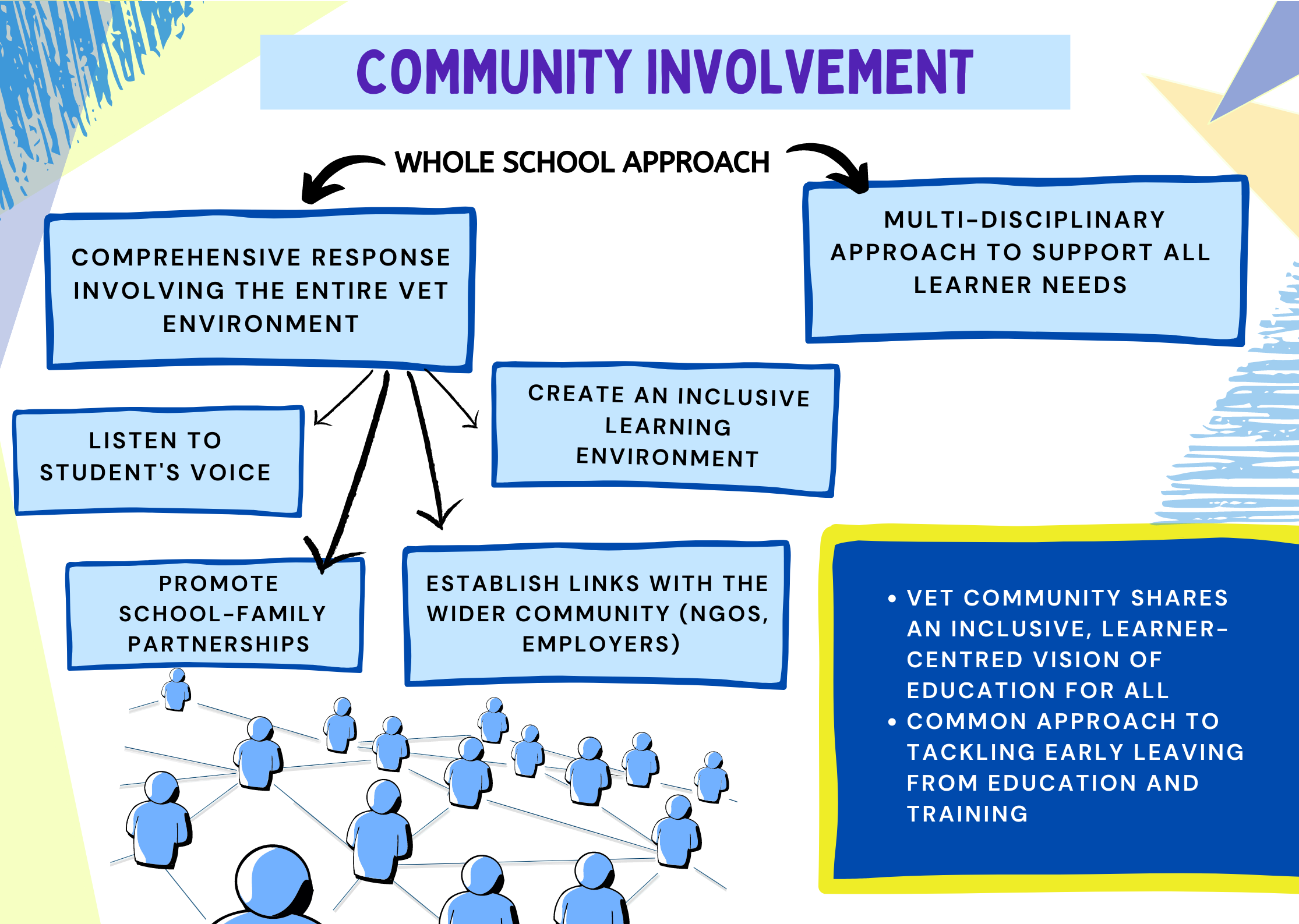Problem statement
Addressed problem: Community involvement
The factors influencing early leaving from education and training are as a result of personal, social, economic, educational, institutional, or family-related reasons. The type of support a learner requires depends on the needs and specific circumstances of the individual. A learner may require a range of interventions on many different dimensions.
A comprehensive response to early leaving from education and training requires action from the entire VET community. This includes VET institution leaders, teaching and non-teaching staff, trainers, parents and families. This requires that VET institutions cooperate with companies, other external stakeholders and the wider community.

Beneficiaries
All learners can benefit from community involvement in their education and training. The aim is to ensure each learner is supported in the most appropriate way to achieve their educational goals. Involving key stakeholders from within the VET institution and beyond can be useful for young people at risk of early leaving from education and training or who have already dropped out and, in particular, for:
- Young people with a high level of disengagement and possibly also complex barriers to learning (e.g. health issues, poverty, etc.)
- Young people who lack motivation to continue learning and who may have a low appreciation of the value of learning
- Young people who have low self-esteem and a lack of longer-term perspective for themselves
Addressing the problem
How can the entire VET community be involved in the prevention of early leaving?
The following tips are offered to policy makers and practitioners involved in the design and delivery of VET.
The information is based on Cedefop research into successful measures. It also draws on the work of EU Member States and the European Commission under the ‘Education and Training (ET) 2020 Working Group on Schools Policy’. This working group developed the European Toolkit for Schools that contains a wide range of practical resources and materials that may be of use to practitioners.
In particular, this toolkit section is inspired by the ET 2020 Working Group on Schools Policy work on the ‘whole school approach’. The consider that the aim of a ‘whole school approach’ is to create a multi-disciplinary approach to support all learner needs; to develop a corporate culture based on a shared understanding of a ‘whole school approach’ and to position and support education as a continuum, starting in the home, through primary, secondary education and beyond. In practice, this approach requires strong leadership and governance. It also requires a strategic vision which is grounded in an overall inclusive, learner-centred concept of education for all.
At the VET institution level, a development / action plan is an important feature of the VET institution improvement process. It can be used for monitoring and self-evaluation of practices and processes.
A VET institution development / action plan designed with the aim of involving the entire VET community, as a minimum, should:
- Be developed and implemented by the entire school community (including learners, parents and families) and with trainers, employers, multi-professional teams and external local services
- Be based on common goals and shared responsibilities with clearly defined roles for all actors involved
- Include targets and measures to address the underlying factors of early leaving from education and training
- Include support measures for VET staff (initial and continued professional development)
- Include the key outcomes and targets it intends to achieve within a specified timeframe
The engagement of the entire VET community within the VET institution and beyond involves a strategic vision which is grounded in an overall inclusive, learner-centred concept of education for all. This means creating safe, welcoming and caring learning environments. Such environments serve to promote student engagement, stimulate motivation and commitment towards learning, and encourage individuals to grow and develop to the best of their ability and to feel a sense of belonging.
As a minimum, welcoming and inclusive environments can be achieved by:
- Offering sports and/or cultural activities to help create a positive climate and a sense of belonging for all learners
- Creating common spaces to promote diversity
- Promoting the use of shared facilities and spaces to build relationships between teachers, trainers, learners and parents
- Ensuring all learners have access to teachers, trainers and other professionals who can support their educational and personal development needs
- Celebrating learner achievement
- Ensuring anti-bullying / conflict resolution strategies are in place
- Engaging staff and pupils in the VET institution surveys and evaluations
It is important all learners are given the opportunity to voice their views relating to their learning experience. They should also be given the opportunity to provide input into institutional decision-making. Utilising the process to empower a young person has a strong impact on their engagement in school life and company life (during in-company training), and their motivation to learn. Formal mechanisms include school councils and school surveys and evaluations. Less formal mechanisms may be required to reach marginalised learners and those at risk of disengagement (e.g. one-on-one sessions, small group work, and motivational project work).
Establishing links with the wider community offers reciprocal benefits to young people, the VET institution and the wider community. This includes establishing links with local NGOs representing minority / vulnerable groups at risk, and other local stakeholders such as employers.
Collaboration with local NGOs and other community organisations representing minority groups and/or vulnerable groups at risk of early leaving could help to ensure that providers are better prepared to work with young people from these particular groups.
Building partnerships between VET institutions and employers at local level can help facilitate school-to-work transition. There are many different ways in which employers can support schools, including offering:
- Career talks and site visits
- Work experience, taster sessions
- To donate equipment/resources
- Provide up to date information about careers in their sectors
Through initial and continued professional development, all teachers and trainers must be given the opportunity to develop their understanding of the factors contributing to early leaving from education and training. This includes developing their capacity to diagnose the varying needs of individual learners and to determine the type of intervention required. In doing so, teachers and trainers should be given the opportunity to develop their skills in relation to educational disadvantage, diversity, conflict resolution, and bullying for example. Providing VET teachers and trainers with opportunities to support their professional development is essential in this respect. This could include, though not limited to:
- Opportunities to work in multi-professional teams – to develop the skills required to work alongside different professionals and to understand the respective contribution other professionals offer
- Having access to a range of teaching methods, tools and approaches in order to facilitate a more inclusive classroom environment
- Collaboration between VET teachers, trainers and other professionals to encourage peer-to-peer learning and support
Actively engaging parents in their child’s education and personal development can be a powerful determinant to reducing the risk of early leaving. There are many ways to build and promote school-family partnerships, such as:
- Promoting parental participation in school decision making – this can be through formal approaches such as parents’ associations, parent councils and parent consultation. Less formal approaches may also be required to ensure the views of all parents are taken into account e.g. in collaboration with local NGOs or other community organisations.
- Creating designated spaces for parents and families can help to build family-school partnerships. Promoting parental participation in formal and/or informal activities provides opportunities for parents to learn new skills, develop positive relationships with the school/other parents and build self-confidence. It can also help parents learn more about the life of the school and the curriculum.
- Parents serve as an important resource to each other. They can also serve as an important resource to the school. Parents could be invited to share their expertise in schools by delivering talks about their job as part of a guidance activity for example.
Promoting school-family partnerships that are built on trust and mutual respect can help identify families with high levels of need. Specific outreach measures can then be deployed to support them. There may be a need for an outreach strategy to individual families facing complex challenges; or it can be useful to designate a specific key school worker with a concrete role to engage with parents.
Expected outcomes
When the entire VET community shares an inclusive, learner-centred vision of education for all, and a common approach to tackling early leaving from education and training, the following outcomes can be expected at different levels:
| INDIVIDUAL | INSTITUTIONAL |
|---|---|
|
|





